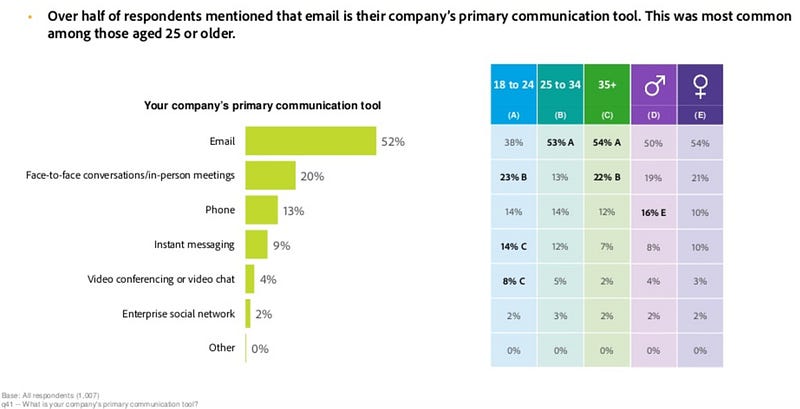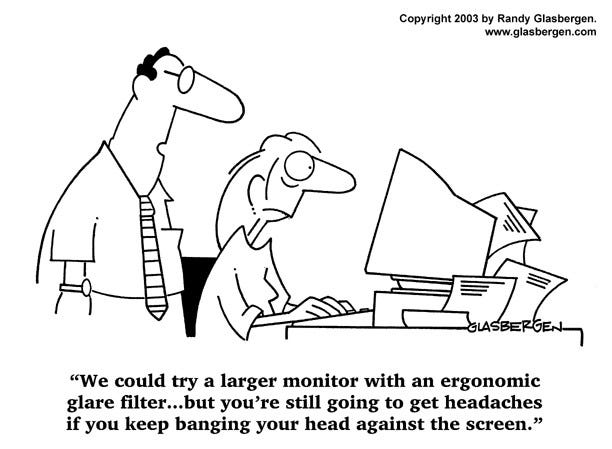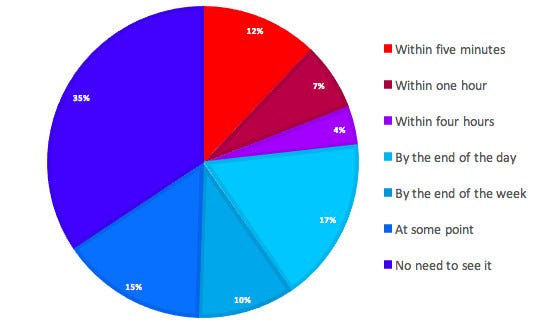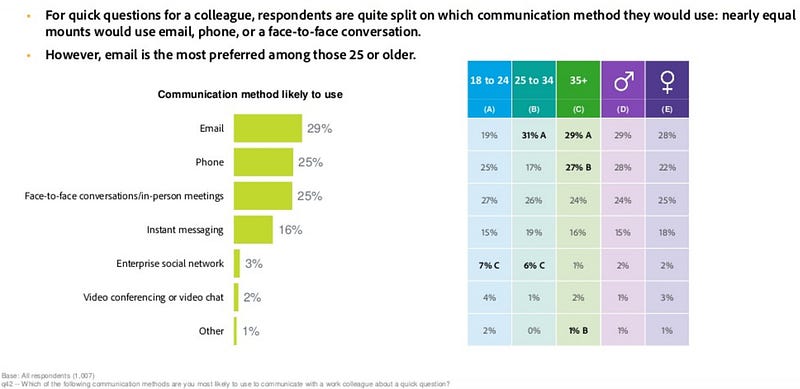Eat the Frog, Don't Chase the Squirrel

How to effectively rise ‘Up’, identify and control unnecessary distractions in order to get things done.
One of our favorite characters in Disney▪Pixar’s movie, “Up”, is the dog, Dug. He is a loveable, enthusiastic member of the team, eager to help in any way he can. However, one of his biggest flaws is that he is continually distracted — even mid-sentence or walk — by what he thinks is a squirrel in his periphery.
While we watch and laugh at how silly it is for Dug to react this way, many of us are constantly chasing our own squirrels during our day. These squirrels manifest themselves through emails, text messages, push notifications, instant messages, phone calls, meetings (plus, emails to plan meetings), social media, and more.
The Way We Communicate is Changing. So Must Your Habits
When you think of how, when, and what information you send to or receive from others both within and outside of your life and work, it seems as though email is the most common method for collaboration and communication amongst individuals and teams. However, as technology and the responsibilities of team members continues to evolve, how information is being shared should be explored, to achieve an efficient, effective, and fulfilling process.
How We Communicate is Ruining Our Productivity
A 2014 CareerBuilder survey revealed that American workers spend about 50% of their time sending or receiving phone calls or text messages, and 23% of their workday on email communications. According to data from Adobe’s 2017 Consumer Email Survey Report, the average worker spends approximately 3.3 hours per day checking and reading work emails. While this number is down 20% from the previous year, it’s still significant. Adobe also found that, while in-person discussions and email were favored by employees, email tended to be their company’s primary communication tool.

Add to that Loughborough University’s case study findings that 70% of emails were reacted to within 6 seconds of receipt and that, following that reaction, it takes an employee — on average — 64 seconds to recover from an email interruption and return to work at the same work rate from which they left.
“If an employee has set up the email application to check for email every 5 minutes then it is possible, if (s)he is a heavy user of email, that there could be 96 interruptions in a normal 8-hour working day…. if it takes on average 1.5 minutes to read and recover from an email and the employee is interrupted every 5 minutes, then this would only leave the employee 3.5 minutes before the next interrupt.”
Based on a 45-hour workweek, this equates to roughly 28% of a person's time. For a worker making $50,000/yr., that’s $14,000 spent on simply reacting to (not actually addressing) email and other low-value distractions. Wow, talk about not adding value!
All Emails Are NOT Created Equal

Does each “ping” require a Pavlovian response? Behavioral economist, Dan Ariely, recently conducted a survey via his website, where participants evaluated the last 40 emails they received and were asked how long they could’ve waited to read it:
- Within five minutes?
- One hour?
- Four hours?
- By end of the day?
- By end of the week later?
- At some point
- Never?
The results were eye-opening. According to respondents, only 12% needed to be seen within 5 minutes of receipt, and the largest majority (35%) did not need to be read at all! That means, of the total number of emails received each day, only about half necessitated any type of response or review.

Surprisingly, though, Adobe found that email was still the most preferred method of communication for quick questions for colleagues, with tools like instant messaging or an internal social network ranking 5th and 6th:

The Impact of These Distractions is High
With the average business employee receiving about 124 emails per day (pre-pandemic), what is the impact of these continual distractions? According to Ariely, the cost is three-fold:
- Time
- Performance
- Stress/emotional well-being
In our attempt to “multi-task”, Ariely points out that we are actually continually switching between each task, not accomplishing two tasks at one time. He cites one study which found that “after switching tasks, it took an average of 23 minutes and 15 seconds for people to get back to their original task”. Ariely notes that distractions can also significantly diminish cognitive performance. These “task-irrelevant thoughts” — thoughts unrelated to the task being performed — can introduce or increase errors. And, continually switching between tasks can be taxing on us emotionally, increasing stress and feelings of pressure.
A study conducted by researchers from UC Irvine and the U.S. Army found that access to email dramatically increased heart rate and stress levels, and reduced the ability to focus, with some participants stating they felt “liberated” and finally “in control” when they did not receive constant email notifications.

With all of this evidence piling up (along with our inbox), what steps can we take to help minimize distractions, allow for more focused effort by “eating the frog”, maximize our daily workload, and strive for inbox nirvana?
Well, for those of us who do not live in France — where legislation was recently passed protecting employees from checking email outside of work hours, or work for a company like Atos — whose CEO banned email entirely, I’ve researched and compiled a list of 10 tips and practices you can explore, through personal habits and technology tools, to stop chasing the squirrel and get things done!
10 Tips to Help You Take Control of Your Email
Both as an individual and business, there are certain practices you can begin to explore and implement that may help reduce the number and frequency of distractions within your workday:
1. Re-Define Priorities.
President Eisenhower once said,
“I have two kinds of problems: the urgent and the important. The urgent are not important, and the important are never urgent.”
An urgent item is one that, if not addressed, can have immediate consequences, whereas important activities are those that can contribute to achieving long-term goals.
When thinking about how you prioritize work, it seems — much of the time — we focus too much on items that are urgent and not enough on those that are important. To remedy this, ask yourself a few simple questions before sending or reviewing:
- Is this something I can take care of immediately? Is it a quick, simple response?
- Is this something that must be addressed immediately, or can I handle it at a later time (today, this week, this month, this year)?
- Does this require action by me, or is it simply informational?
- Can or should someone else address this item?
- Does this item contribute to my goals?
2. Create a Task/To-Do List.
Your inbox should not be your To-Do list. To paraphrase a sandwich analogy from Melvin Mann, your goal is to actually make the sandwich, not simply check to see if new orders are coming in and let them pile up.
Before you even look at your computer in the morning (and/or before you leave for the previous day), Peter Bregman suggests taking ~18 minutes to plan out your day, identifying and writing down activities you can “realistically accomplish that will further your goals and allow you to leave at the end of the day feeling like you’ve been productive and successful” and schedule them in your calendar. Then, throughout the day, reassess what you accomplished to refocus on your goals.
However, whatever you put on the list is a commitment — it must get done. Mann feels that the act of committing is your way of saying it’s something you’re going to do, not just that it’s a good idea. It should have a designated date and time for completion, else there’s no consequence to it not being completed. Wherever and however you are capturing and monitoring your to-do’s, it’s best if they are visible, shareable, transparent, and traceable, especially if working with a team or where there are dependencies or hand-offs to other individuals.
There are several tools out there that can be used to capture your daily/weekly/monthly/periodic To-Dos. Within Outlook and Gmail, categories and labels (respectively) can be used to help identify the type of tasks and appointments that are added to your To-Do list.
3. Do the Most Important Task First.
Mark Twain once said if the first thing you do each morning is to eat a live frog, you can go through the day with the satisfaction of knowing that that is probably the worst thing that is going to happen to you.
This analogy is the basis of Brian Tracy’s book (conveniently titled) “Eat that Frog: 21 Great Ways to Stop Procrastinating and Get More Done in Less Time”. Tracy believes that, by starting each day with your most important task (your MIT) and working through it completely with no distractions before you move on to the next task, you’ll not only tackle procrastination and feel accomplished, but you can develop a “positive addiction” to the sense of completion and contribution.
4. Adopt ‘Inbox Zero’ Principles.
Contrary to widely held belief, the concept of Inbox Zero does not correlate to the number of messages in your inbox. When Merlin Mann first coined the term and idea, it was centered around the concept that your time and attention are finite; therefore, you should spend as close to zero time on your email as possible. Joel Spolsky talks about your time as a literal box (with limited space), where each task — regardless of size — takes up a certain amount of space and has an associated opportunity cost.
One of the key systems Mann recommends is that, whenever you review your inbox, take proactive steps by completing one of 6 actions — immediately — and process to zero. Checking your email is not sufficient; however, processing is more than checking but less than responding. Whenever your inbox is reviewed, one of these six actions should be taken by simply answering the question “What action must I take” to determine where the message should go.
- Delete. If you do not need this now or in the future, Delete it.
- Archive. If you will need this later, Archive it.
- Delegate. Can or should someone else handle this? Forward it (but also give yourself a follow-up task to check it’s done, if necessary)
- Respond. Can you respond in a couple of minutes and a few sentences? Respond now.
- Defer. If it’s an email-based task but requires a little more work to respond to, Defer it by moving it to a time-based folder.
- Do. If it takes less than 2 minutes to complete and you can do it now, do it now — don’t defer it for later. Or defer it on your calendar if it cannot or will not be done immediately.
Your inbox should, in essence, only represent the items you haven’t yet read. By doing this, you are significantly reducing the amount of time and attention that needs to be spent managing your email messages whenever they come in.
In addition, don’t feel the need to reply unless your feedback is requested or expected.
5. Simplify your Email Folders & Rely on Searching.
We’ve all done the “where did I file this” or “where should I file this” tango a few times. Often one-subject or client emails expand and can include multiple “conversations”. Where do those get filed?
If you have some crazy filing system with multiple folders when was the last time you actually located an old email by scrolling through the folder? You most probably used your search tools. Labels and Categories can be used to classify your emails by context if needed. However, spending time figuring out where you’re going to file an email you’re archiving is a valueless use of your time.
Remember, your daily time box is only so big. Do you want to use up your precious minutes doing something so worthless? At the end of the day, messages need to be easy to find, not aesthetically pleasing.
Efficiency experts and rock-star CEOs alike have touted the idea of restructuring your email to only have 5 (yes, you heard correctly, 5) folders:
- Inbox. This is where new, unread messages should reside and be processed for completion or filing to another folder. No read emails should remain in your inbox.
- Today. All messages that require a response at some [scheduled] time today. At the end of the day, this folder should be empty, unless an item was intentionally deferred to the following day. Messages should not remain in the Today folder longer than a day, else you’ve just morphed your bloated Inbox folder into a bloated Today folder.
- This Week. Messages that require a response at some [scheduled] time this week. At the end of the week, this folder should be empty.
- This Month/Quarter. Messages that require a response at some [scheduled] time this month or quarter. Depending on your role, these may be separate folders, or you may only choose to have one or the other.
- FYI. Messages that require no response, but you feel you may need to reference later. You can use labels and categories to classify these messages, as needed. However, if the information is that important it should not live in an email message. It should be properly logged in your ATS, CRM, or other collaborative, team-accessible platform.
Remember, your inbox should not be your to-do list. Messages are meant to inform, not represent an action to be completed. Anything that requires action should be scheduled as a follow-up task. Also, whatever you put in the folder is a commitment — it must get done, else there’s no consequence to it not being completed.
Tip: To help speed up the filing of the emails when you process them, explore setting up and using keyboard shortcuts.
This approach could also be applied to messages you are sending to others. Consider automatically creating a follow-up task for the recipient based on desired response time, or include FYI, This Week, Due by MM/DD in the subject line of the message to aid them in better prioritizing their response.
6. Use email rules or filters to control the distraction and noise.
Arianna Huffington, the founder and CEO of Thrive Global, had a corporate email rule that will automatically delete all emails an employee receives when they are on vacation. While this may seem a bit extreme for some organizations, the idea of leveraging email rules and filters to minimize distraction and create better focus on now vs. later activities is not. Examples of where rules and filters can help you do more work and less managing of email messages include:
- News Feed Rule. Any emails received from newsletters, blogs, etc. you subscribe to can automatically be moved to one of your folders to be reviewed during a pre-defined, time-boxed period (e.g. Today, This Week, This Month/Quarter). Weekly newsletters may go to your This Week folder, whereas periodic blog posts or learning may be filed into This Month or This Quarter.
- Category Rule. Based on either keyword, subject, or sender email address, you can have a rule to automatically add a category or label (such as “Learning/Enrichment”, “Marketing”, “Sales”, “Project A”, etc.)
- Follow-Up Rule. When a message is sent with a certain word(s) in the subject, to a particular individual or group, marked as important, etc., automatically create a follow-up task to ensure necessary response or action was taken.
- Arrange By. When viewing messages in a folder, you can choose to arrange by a variety of options, such as Date, Sender, Category, Importance.
Also, don’t be shy about unsubscribing to digital junk mail or even blocking spammers
7. Schedule Your Inbox Time.
How many times have you ended the day feeling as though all you did was react and respond to the emails that continued to come in your inbox, never able to resume (or even start) the task(s) you set out to complete?
We are perfectly fine with scheduling time blocks for meetings and appointments. Why don’t we do the same for the rest of the work we need to accomplish? You remember the stats earlier about the frequency of distractions and the time it takes to reset? Wouldn’t it be better to schedule the time you process your emails in your inbox, thereby seizing the reigns of your day and — in essence — planning for the distraction? There are a few approaches experts recommend for this practice:
- Block time out on your calendar each day to process your emails. Depending on your role, this may need to be every hour or once or twice a day. Remember, if you’re scheduling it, you should have less to handle at any given time, since you’re processing to zero each hour
- Don’t leave your email client open all day. Only open it when it’s your time to process emails. This is to ensure that little box or “ping” of incoming messages doesn’t pull your focus from the work you should be completing.
- If you don’t think you can close it out (maybe due to meetings — I need those meeting reminders!), schedule your email updates to happen less frequently, only checking and pulling in new messages when it’s time to process them.
- Include a message in your email that indicates how often email is checked and, if it’s urgent, to call.
An email auto-check set for every minute means 60 potential distractions every hour, or almost 500 per day. How many distractions was that really worth? In a week, how many crucial, instantly actionable emails did you receive to make it worth shifting your attention over 2000 times?
The goal is to aim for reviewing your email no more than once per hour. Check it for 10 minutes, process to zero, and close it out. Shut it off, and focus on getting work done.
8. Leverage Email Templates to Save Time.
Do you find that you are sending the same or similar messages repeatedly? Identify what percentage of your emails have a similar message, or where you’re saying the same thing over and over, and create and use a template with merge fields. Doing so can not only shorten the amount of time you’re spending crafting the message but can also promote and ensure consistent, branded messaging.
In addition to the actions you can personally take to control the chaos, we’ve included a few more that may align both you and those with whom you’re collaborating to help create a virtuous cycle of communication harmony:
9. Redefine and Refine Your Delivery Model.
Email has become the de-facto information distribution delivery method for individuals and organizations. Before sending your email, first consider whether there is a better method to communicate based on the type of ‘conversation’:
- Questions for a group = Chat/Messaging Tool. Are emails sent to a large group in the hopes that someone will answer? Use a chat or messaging tool such as Slack or Microsoft Teams to broadcast your message. This allows people to choose when and if they participate and whether they want/need to view the answer. Answers can then also be easily searched for future reference.
- Knowledge sharing = Wiki. Are email mailing lists being used for knowledge sharing? Does everyone on the list need to know about what is being sent? Use a shared, collaborative space tool like a wiki or self-service help application for helpful, but not time-sensitive, information that can be referenced when needed.
- Immediate need = Text or Phone/Voice Call. Does this communication require an immediate response? Does the recipient prefer text messages? A text or phone call to the recipient may be the best way to connect quickly and resolve the open item promptly.
- Data = Dashboard Metric or Performance Report. Are you emailing information that is better viewed via a report or visual dashboard? When a report is emailed, the data contained therein represents a snapshot in time — the time the report was generated and sent. If the information you’re sharing can change frequently (minute, hour, day, week, month, etc.), leveraging dashboard views and real-time reports may better serve and support what you’re trying to evaluate and measure.
10. Identify the Right Place for the Information to Live.
Many argue that email is, in essence, a black hole. It’s where information goes, never to be found again — especially by your colleagues, and, even many times, you yourself. It was never meant to be a collaborative tool — where multiple individuals can discuss and share ideas.
Melvin Mann talks about email simply being a medium — a method for passing information from one place to another. It’s the information contained within the email that needs to be “liberated into other places”, such as appointments, tasks, documents, etc. If the information is important enough, have it logged in the best place to help support and align your team and resources, so they’re armed with the most current, accurate, and complete information.
In Summary
You may already be thinking, voicing, or expecting to hear arguments against implementing these practices:
“I have [clients, colleagues, bosses, etc.] who email me and expect immediate responses!”
That’s the effect of how email has evolved from its original intent to what it is today, not the cause. If actually getting work done is important to you and your organization, which — in the end — has a direct benefit and impact to those colleagues, clients, and bosses, a systemic change to inefficient behaviors and communication must be taken.
Just as with raising children or cooking fish in the company microwave, it’s important to negotiate and establish boundaries about how accessible you can and should be within your organization, and have conversations to agree collectively on how you interact with email. In addition, be mindful and think about the digital junk you are creating for others, as well.
Is your inbox already a bloated mess and you don’t know where to start? How about instituting an “Email DMZ (Demilitarized Zone)”? Drag all current emails in your inbox to a [temporary] DMZ folder. You still need to review it but can do it in bursts. Then don’t repeat it. Create a fresh start with your [only] 5 new email folders, email process schedule, and MIT.
Bonus: If you want to roughly estimate how much of your time you’ve spent on work emails, check out this calculator the Washington Post created. While slightly depressing, hopefully, it will give you the motivation you need to shake up the ways in which you communicate and manage your day!
Additional Resources
If you want to learn more about streamlining your priorities and effort during your workday (and personal time, too!), here are a few additional resources:
Merlin Mann: http://www.43folders.com/izero
Getting Things Done: The Art of Stress-Free Productivity, by David Allen
David Allen Google Tech Talk video
Eat that Frog!: 21 Great Ways to Stop Procrastinating and Get More Done in Less Time, by Brian Tracy
Peter Thiel’s Extreme Philosophy of Focus and Prioritization
Cover Photo by David Clode on Unsplash

